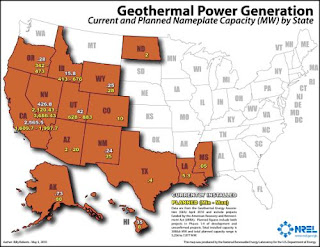- RIW
When you mention the words “renewable energy,” most people immediately think of wind and solar. Over the last decade, renewables in the United States (excluding hydropower) have more than tripled.
In 2009, renewables reached 53 gigawatts of installed capacity. Renewables have grown at a compound annual growth rate of 14 percent since 2000.
It’s no big secret that wind and solar are the fastest-growing renewable sectors. In 2009 alone, wind installations here grew by 39 percent and solar PW grew by nearly 52 percent.
Even with these heady growth figures, renewables represent a very small percentage of our overall installed electrical generation capacity: about 4.7 percent as of the end of 2009.
The renewable that’s garnered the least amount of attention in America’s three-year push to renewables is geothermal energy. In stark contrast to the growth figures for solar and wind, geothermal has grown a mere 1.2 percent annually from 2000 to 2009.
In spite of those dismal growth figures, the United States leads the world in geothermal installed capacity at about 15.2 GW as of the end of 2009. Most of that is installed in California.
Advantage Over Wind, Solar
Geothermal energy has one advantage over wind and solar. It doesn’t care whether the wind is blowing, or if it’s a sunny day. The energy available from geothermal is available 24 hours a day, every day of the year.
That makes it available as a baseload source of renewable energy, something most other renewables aren’t capable of.
So why isn’t the United States deploying more of this eco-friendly renewable resource? It’s certainly not because we don’t have the potential resources. Take a look at the map below from the National Renewable Energy Laboratory.
As you can see from the map below, most of the present geothermal electrical generation is located in California, with over 2.5 GW of geothermal electrical generation. This satisfies about five percent of California’s total energy demand.
However, it’s interesting to note that Nevada has more projects in the planning stages, and it certainly has the potential sites to supply them.
How Geothermal Power Works
Geothermal power production is a relatively simple process. At least two wells are drilled into a known geothermal site. The down-hole water or steam temperature is evaluated to determine what type of system will be constructed, but most of them ultimately involve the use of steam turbines connected to electrical generators.
The water, which can be as hot as 700 degrees Fahrenheit, is brought to the surface, flashed into steam, and used to spin a turbine connected to an electrical generator. It’s then re-condensed and re-injected into the earth through a second well.
The Hold Up
While geothermal power plants are relatively inexpensive to build compared to coal, natural gas, or nuclear plants, they have to be located where the resources are. These are, particularly in the case of Nevada, often in the middle of nowhere.
Lack of nearby transmission lines, especially in sparsely populated western states, has hampered the growth of geothermal.
While the plants are relatively inexpensive, development and construction can take anywhere from four to eight years. This is far longer than solar and wind, and it means potential investors have to wait much longer to recoup their capital investment.
There’s risk involved, as well. Even after extensive testing, not all geothermal resources produce as much energy as originally anticipated. This has led more recent projects to be developed incrementally in order to mitigate this risk and the costs associated with it.
Taking a Back Seat
Ormat Technologies, Inc. (NYSE: ORA) is the developer and operator of the most geothermal resources in the United States. Ormat is vertically integrated, designing the plants and equipment, and developing and operating the final site.
Due to a lack of investment in geothermal, the company has had a somewhat lack-luster year, with its stock down over 35 percent in the last 12 months.
Last quarter, it announced that revenue was up by about 9.2 percent over the same quarter a year ago, but earnings came in at $0.02 per share, well below analysts’ estimates of $0.14 per share. Not exactly outstanding results.
In spite of the zero-carbon footprint of geothermal, there’s a glut of natural gas in this country. There’s also a much bigger focus on wind and solar. At least for now, geothermal seems to be relegated to the back of the renewables bus.
Perhaps this will change at some point in the future, but for the present, investors would be prudent to invest their dollars elsewhere in the energy sector.
Good investing,
David Fessler




Man that was a fantastic article. This article is one of the best I have seen so far. I specialy liked the maps on US hot zones. I just finished reading this article I am linking. It has a really good video I like.
ReplyDeletehttp://cognitiveanomalies.com/what-is-geothermal-energy-what-are-geothermal-energy-advantages-and-disadvantages/
Noel F. Dyer
Here give a good post. This post give a well information for the Geothermal work. Geothermal use a many way which is helpful to get a more energy source.
ReplyDeleteyodergeothermal.com
Hi there! Thank you so much for sharing your knowledge about geothermal with us. You have such a very informative post. It was very well said. Anyway, in addition to what you have written, heat pumps provide winter heating by extracting heat from a source and transferring it into a building. Heat can be extracted from any source, no matter how cold, but a warmer source allows higher efficiency. A ground source heat pump uses the top layer of the earth's crust as a source of heat, thus taking advantage of its seasonally moderated temperature. Our drill rigs are all wheel drive with a low center of gravity thus making it possible to transverse difficult sites. Geothermal NH
ReplyDelete